介绍中国菜系的英语p
- 格式:ppt
- 大小:2.38 MB
- 文档页数:20

八大菜系英文介绍以下是八大菜系的英文介绍:1. 鲁菜:Shandong Cuisine, also known as Lu Cuisine, is the representative cuisine of the North and Northeast China, with a focus on seafood, pork, and chicken. It is known for its simple cooking methods, fresh ingredients, and rich flavors.2. 川菜:Sichuan Cuisine, also known as Chuan Cuisine, is a spicy and pungent cuisine from Sichuan Province in China. It is famous for its fiery peppers and rich sauces, and often features pork, chicken, and seafood.3. 粤菜:Cantonese Cuisine is the representative cuisine of Guangdong Province in China, known for its freshness, simplicity, and unique seasonings. It emphasizes the use of high-quality ingredients and pays attention to the presentation of dishes.4. 闽菜:Fujian Cuisine is a coastal cuisine from Fujian Province in China. It emphasizes seafood, fresh vegetables, and rice dishes. The cooking methods are unique, with a focus on stewing, steaming, and deep-frying.5. 苏菜:Jiangsu Cuisine is a representative cuisine of the Yangtze River Delta region in China. It emphasizes freshness, tenderness, and mild flavors. The cooking methods are diverse, including stewing, steaming, frying, and braising.6. 浙菜:Zhejiang Cuisine is a representative cuisine of the eastern region of China, known for its simplicity and unique flavors. It often features rice dishes, seafood, and various kinds of meat. The cooking methods include stewing, steaming, and frying.7. 湘菜:Xiang Cuisine is a spicy and pungent cuisine from Hunan Province in China. It emphasizes the use of fresh ingredients and fiery peppers, often featuring pork, chicken, and beef. The cooking methods include stewing, steaming, and deep-frying.8. 徽菜:Anhui Cuisine is a traditional Chinese cuisine from Anhui Province, known for its unique flavors and seasonings. The main ingredients include pork, chicken, duck, and various kinds of vegetables. The cooking methods include stewing, steaming, frying, and braising.。
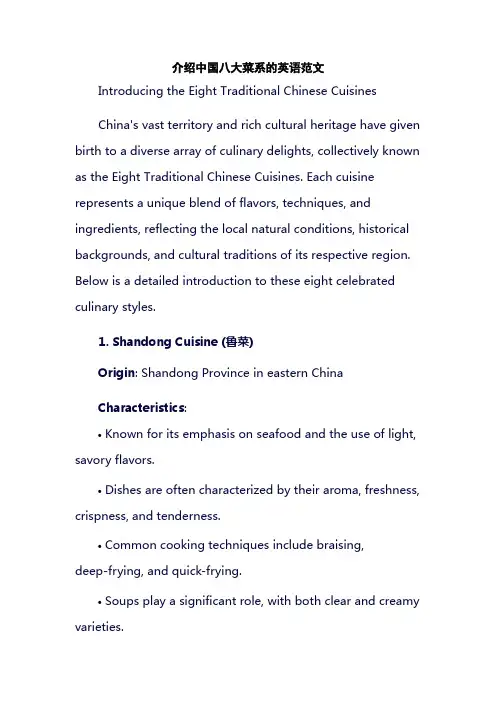
介绍中国八大菜系的英语范文Introducing the Eight Traditional Chinese CuisinesChina's vast territory and rich cultural heritage have given birth to a diverse array of culinary delights, collectively known as the Eight Traditional Chinese Cuisines. Each cuisine represents a unique blend of flavors, techniques, and ingredients, reflecting the local natural conditions, historical backgrounds, and cultural traditions of its respective region. Below is a detailed introduction to these eight celebrated culinary styles.1. Shandong Cuisine (鲁菜)Origin: Shandong Province in eastern ChinaCharacteristics:•Known for its emphasis on seafood and the use of light, savory flavors.•Dishes are often characterized by their aroma, freshness, crispness, and tenderness.•Common cooking techniques include braising,deep-frying, and quick-frying.•Soups play a significant role, with both clear and creamy varieties.Popular Dishes: Sweet and sour carp, braised abalone, fried sea cucumber, and sea cucumber braised with scallion.2. Sichuan Cuisine (川菜)Origin: Sichuan Province in southwestern ChinaCharacteristics:•Famous for its bold and spicy flavors, often accompanied by a numbing sensation.•Heavily relies on the use of chili peppers, garlic, and Sichuan peppercorns.•Dishes exhibit a wide range of tastes and textures.Popular Dishes: Mapo tofu, kung pao chicken, hot pot, and spicy boiled fish.3. Cantonese Cuisine (粤菜)Origin: Guangdong Province in southern ChinaCharacteristics:•Known for its delicate and fresh flavors, with a strong emphasis on seafood.•Techniques such as stir-frying and steaming are widely used.•Minimal use of spices allows the natural flavors of ingredients to shine.Popular Dishes: Dim sum, sweet and sour pork, wonton soup, and honey-glazed barbecued pork.4. Jiangsu Cuisine (苏菜)Origin: Jiangsu Province in eastern ChinaCharacteristics:•Renowned for its delicate and light flavors, emphasizing the freshness and seasonality of ingredients.•Dishes are meticulously prepared and presented.•Aquatic products are a staple, and cooking techniques include stewing, braising, and roasting.Popular Dishes: Squirrel-shaped mandarinfish, lion's head meatballs, and salted duck.5. Zhejiang Cuisine (浙菜)Origin: Zhejiang Province in eastern ChinaCharacteristics:•Known for its fresh and tender flavors, with a focus on seafood and bamboo shoots.•Techniques such as steaming, braising, and stewing are prevalent.•Dishes often showcase the natural sweetness and tenderness of ingredients.Popular Dishes: Dongpo pork, West Lake vinegar fish, and beggar's chicken.6. Hunan Cuisine (湘菜)Origin: Hunan Province in central ChinaCharacteristics:•Similar to Sichuan cuisine in its bold and spicy flavors but less numbing and more aromatic.•Heavily features chili peppers, garlic, and other spices.•Dishes often have a complex and layered taste profile.Popular Dishes: Chairman Mao's red-braised pork, steamed fish head with chopped chili, and stir-fried pork with smoked tofu.7. Fujian Cuisine (闽菜)Origin: Fujian Province in southeastern ChinaCharacteristics:•Known for its emphasis on seafood and umami-rich flavors.•Uses a wide variety of ingredients, including seafood, mushrooms, and bamboo shoots.•Techniques such as braising and stewing are common.Popular Dishes: Buddha Jumps Over the Wall, oyster omelette, and fish ball soup.8. Anhui Cuisine (徽菜)Origin: Anhui Province in eastern ChinaCharacteristics:•Known for its use of wild herbs and game meats, as well as its braising, stewing, and slow-cooking techniques.•Dishes emphasize the natural flavors of the ingredients and often have a salty and umami taste profile.Popular Dishes: Braised turtle with ham, salt-baked chicken, and bamboo shoots with pork belly.In summary, the Eight Traditional Chinese Cuisines offer a rich tapestry of flavors, techniques, and ingredients that reflect the diversity and depth of China's culinary heritage. Each cuisine is a testament to the ingenuity and creativity of itschefs, who have honed their skills over generations to create dishes that are both delicious and deeply rooted in their respective cultural traditions.。
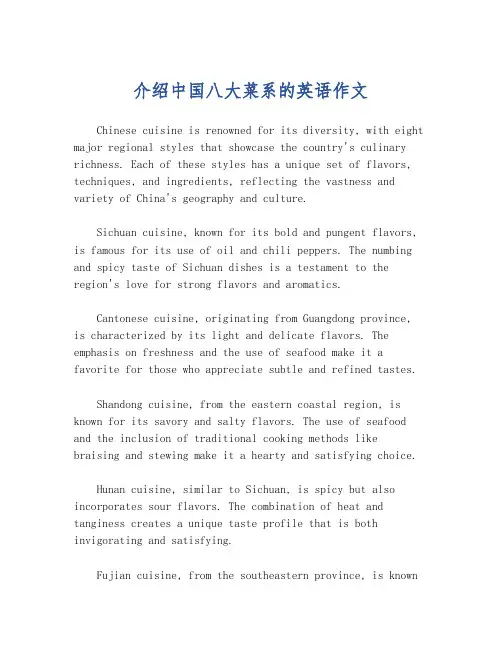
介绍中国八大菜系的英语作文Chinese cuisine is renowned for its diversity, with eight major regional styles that showcase the country's culinary richness. Each of these styles has a unique set of flavors, techniques, and ingredients, reflecting the vastness and variety of China's geography and culture.Sichuan cuisine, known for its bold and pungent flavors, is famous for its use of oil and chili peppers. The numbing and spicy taste of Sichuan dishes is a testament to the region's love for strong flavors and aromatics.Cantonese cuisine, originating from Guangdong province, is characterized by its light and delicate flavors. The emphasis on freshness and the use of seafood make it a favorite for those who appreciate subtle and refined tastes.Shandong cuisine, from the eastern coastal region, is known for its savory and salty flavors. The use of seafood and the inclusion of traditional cooking methods likebraising and stewing make it a hearty and satisfying choice.Hunan cuisine, similar to Sichuan, is spicy but also incorporates sour flavors. The combination of heat and tanginess creates a unique taste profile that is both invigorating and satisfying.Fujian cuisine, from the southeastern province, is knownfor its emphasis on seafood and its light, fresh flavors. The use of vinegar and the focus on preserving the natural taste of ingredients make it a popular choice for health-conscious diners.Jiangsu cuisine, from the lower Yangtze River region, is famous for its sweet and mild flavors. The delicate taste and the use of sugar in many dishes make it a favorite for those who enjoy a more gentle culinary experience.Zhejiang cuisine, from the eastern coastal province, is characterized by its fresh and light flavors. The region's proximity to the sea influences the cuisine, with a focus on seafood and a preference for simple, clean flavors.Finally, Anhui cuisine, from the inland province, is known for its complex flavors and the use of wild game and freshwater fish. The rich and savory dishes are a reflection of the region's history and natural resources.These eight culinary traditions represent just a fraction of the vast array of flavors and techniques found in Chinese cuisine, each offering a unique glimpse into the country's rich and diverse food culture.。
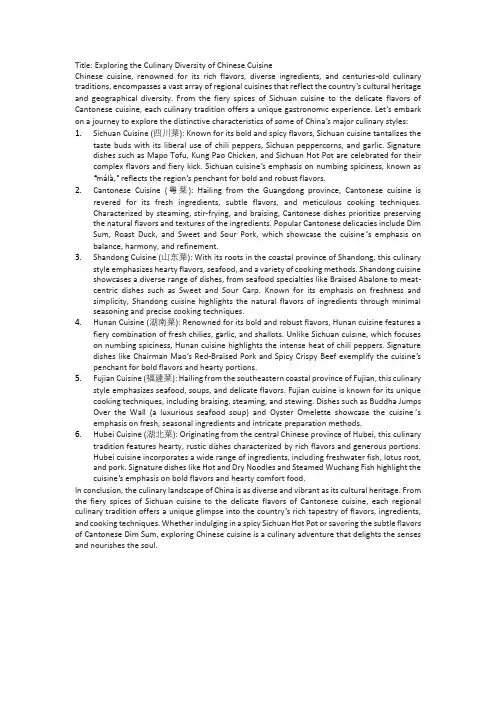
Title: Exploring the Culinary Diversity of Chinese CuisineChinese cuisine, renowned for its rich flavors, diverse ingredients, and centuries-old culinary traditions, encompasses a vast array of regional cuisines that reflect the country’s cultural heritage and geographical diversity. From the fiery spices of Sichuan cuisine to the delicate flavors of Cantonese cuisine, each culinary tradition offers a unique gastronomic experience. Let’s embark on a journey to explore the distinctive characteristics of some of China’s major culinary styles: 1.Sichuan Cuisine (四川菜): Known for its bold and spicy flavors, Sichuan cuisine tantalizes thetaste buds with its liberal use of chili peppers, Sichuan peppercorns, and garlic. Signature dishes such as Mapo Tofu, Kung Pao Chicken, and Sichuan Hot Pot are celebrated for their complex flavors and fiery kick. Sichuan cuisine’s emphasis on numbing spiciness, known as “málà,” reflects the region’s penchant for bold and robust flavors.2.Cantonese Cuisine (粤菜): Hailing from the Guangdong province, Cantonese cuisine isrevered for its fresh ingredients, subtle flavors, and meticulous cooking techniques.Characterized by steaming, stir-frying, and braising, Cantonese dishes prioritize preserving the natural flavors and textures of the ingredients. Popular Cantonese delicacies include Dim Sum, Roast Duck, and Sweet and Sour Pork, which showcase the cuisine’s emphasis on balance, harmony, and refinement.3.Shandong Cuisine (山东菜): With its roots in the coastal province of Shandong, this culinarystyle emphasizes hearty flavors, seafood, and a variety of cooking methods. Shandong cuisine showcases a diverse range of dishes, from seafood specialties like Braised Abalone to meat-centric dishes such as Sweet and Sour Carp. Known for its emphasis on freshness and simplicity, Shandong cuisine highlights the natural flavors of ingredients through minimal seasoning and precise cooking techniques.4.Hunan Cuisine (湖南菜): Renowned for its bold and robust flavors, Hunan cuisine features afiery combination of fresh chilies, garlic, and shallots. Unlike Sichuan cuisine, which focuses on numbing spiciness, Hunan cuisine highlights the intense heat of chili peppers. Signature dishes like Chairman Mao’s Red-Braised Pork and Spicy Crispy Beef exemplify the cuisine’s penchant for bold flavors and hearty portions.5.Fujian Cuisine (福建菜): Hailing from the southeastern coastal province of Fujian, this culinarystyle emphasizes seafood, soups, and delicate flavors. Fujian cuisine is known for its unique cooking techniques, including braising, steaming, and stewing. Dishes such as Buddha Jumps Over the Wall (a luxurious seafood soup) and Oyster Omelette showcase the cuisine’s emphasis on fresh, seasonal ingredients and intricate preparation methods.6.Hubei Cuisine (湖北菜): Originating from the central Chinese province of Hubei, this culinarytradition features hearty, rustic dishes characterized by rich flavors and generous portions.Hubei cuisine incorporates a wide range of ingredients, including freshwater fish, lotus root, and pork. Signature dishes like Hot and Dry Noodles and Steamed Wuchang Fish highlight the cuisine’s emphasis on bold flavors and hearty comfort food.In conclusion, the culinary landscape of China is as diverse and vibrant as its cultural heritage. From the fiery spices of Sichuan cuisine to the delicate flavors of Cantonese cuisine, each regional culinary tradition offers a unique glimpse into the country’s rich tapestry of flavors, ingredients, and cooking techniques. Whether indulging in a spicy Sichuan Hot Pot or savoring the subtle flavors of Cantonese Dim Sum, exploring Chinese cuisine is a culinary adventure that delights the senses and nourishes the soul.。
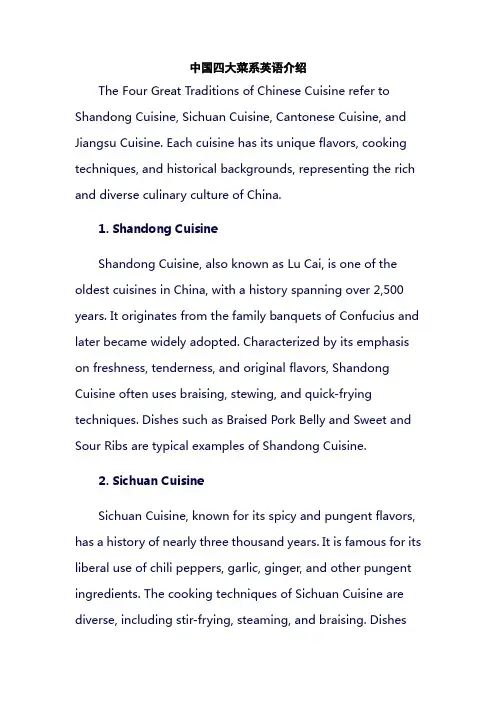
中国四大菜系英语介绍The Four Great Traditions of Chinese Cuisine refer to Shandong Cuisine, Sichuan Cuisine, Cantonese Cuisine, and Jiangsu Cuisine. Each cuisine has its unique flavors, cooking techniques, and historical backgrounds, representing the rich and diverse culinary culture of China.1. Shandong CuisineShandong Cuisine, also known as Lu Cai, is one of the oldest cuisines in China, with a history spanning over 2,500 years. It originates from the family banquets of Confucius and later became widely adopted. Characterized by its emphasis on freshness, tenderness, and original flavors, Shandong Cuisine often uses braising, stewing, and quick-frying techniques. Dishes such as Braised Pork Belly and Sweet and Sour Ribs are typical examples of Shandong Cuisine.2. Sichuan CuisineSichuan Cuisine, known for its spicy and pungent flavors, has a history of nearly three thousand years. It is famous for its liberal use of chili peppers, garlic, ginger, and other pungent ingredients. The cooking techniques of Sichuan Cuisine are diverse, including stir-frying, steaming, and braising. Disheslike Mapo Tofu, Spicy Chicken, and Fish Fragrant Prawns are all representative of Sichuan Cuisine's unique flavors.3. Cantonese CuisineCantonese Cuisine, originating in Guangdong Province, is renowned for its light and delicate flavors. It emphasizes the freshness and original taste of ingredients, often using steaming, stir-frying, and roasting techniques. Cantonese Cuisine is also known for its innovative use of seafood and its meticulous preparation methods. Dishes like Roast Goose, Dim Sum, and Steamed Fish with Ginger and Scallions are typical examples of Cantonese Cuisine.4. Jiangsu CuisineJiangsu Cuisine, also known as Su Cai, is known for its emphasis on freshness, tenderness, and original flavors. It often uses light seasonings and cooking techniques such as steaming, stewing, and braising to preserve the natural flavors of the ingredients. Dishes like Lion's Head Meatballs, Crab Meat Soup, and Sweet and Sour Pork Ribs are representative of Jiangsu Cuisine's delicate and refreshing flavors.In conclusion, the Four Great Traditions of Chinese Cuisine each have their unique characteristics and flavors, reflecting the rich and diverse culinary culture of China. Whether you prefer the freshness and tenderness of Shandong Cuisine, the spicy and pungent flavors of Sichuan Cuisine, the light and delicate flavors of Cantonese Cuisine, or the refreshing and delicate flavors of Jiangsu Cuisine, there is sure to be a dish that will satisfy your taste buds.。
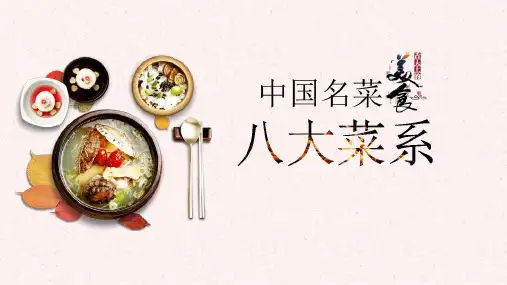



介绍中国八大菜系的英语作文Chinese cuisine is known for its diversity and rich flavors, with eight major regional cuisines that showcase the country's culinary heritage. Let's take a closer look at each of these eight major Chinese cuisines:1. Cantonese cuisine:Cantonese cuisine, also known as Yue cuisine, originates from the Guangdong province in southern China. It is characterized by its delicate and fresh flavors, as well as its emphasis on seafood and stir-frying techniques. Popular dishes include dim sum, sweet and sour pork, and wonton soup.2. Sichuan cuisine:Sichuan cuisine, hailing from the Sichuan province in southwestern China, is famous for its bold and spicy flavors. The liberal use of garlic, chili peppers, and Sichuan peppercorns gives Sichuan dishes their distinctive numbing and spicy taste. Popular dishes include mapo tofu, kung pao chicken, and hot pot.3. Shandong cuisine:Shandong cuisine, also known as Lu cuisine, comes from the Shandong province in eastern China. It is known for its emphasis on seafood and the use of light, savory flavors. Shandong dishes often feature braising, deep-frying, and quick-frying techniques. Popular dishes include sweet and sour carp, braised abalone, and fried sea cucumber.4. Jiangsu cuisine:Jiangsu cuisine, originating from the Jiangsu provincein eastern China, is known for its delicate and light flavors. It emphasizes the freshness and seasonality of ingredients, as well as the meticulous presentation of dishes. Popular dishes include squirrel-shaped mandarin fish, lion's head meatballs, and salted duck.5. Zhejiang cuisine:Zhejiang cuisine, also known as Zhe cuisine, comes from the Zhejiang province in eastern China. It is characterized by its fresh and tender flavors, as well as its emphasis on seafood and bamboo shoots. Zhejiang dishes often feature steaming, braising, and stewing techniques. Popular dishes include Dongpo pork, West Lake vinegar fish, and beggar's chicken.6. Hunan cuisine:Hunan cuisine, originating from the Hunan province in central China, is known for its bold and spicy flavors. It is similar to Sichuan cuisine but is less numbing and more aromatic. Popular dishes include Chairman Mao's red-braised pork, steamed fish head with chopped chili, and stir-fried pork with smoked tofu.7. Fujian cuisine:Fujian cuisine, coming from the Fujian province in southeastern China, is known for its emphasis on seafood and umami-rich flavors. It features a wide variety of ingredients, including seafood, mushrooms, and bamboo shoots. Popular dishes include Buddha Jumps Over the Wall, oyster omelette, and fish ball soup.8. Anhui cuisine:Anhui cuisine, originating from the Anhui province in eastern China, is known for its use of wild herbs and game meats. It emphasizes braising, stewing, and slow-cooking techniques to bring out the natural flavors of theingredients. Popular dishes include braised turtle with ham, salt-baked chicken, and bamboo shoots with pork belly.中国菜系以其多样性和丰富的口味而闻名,有八大主要菜系展示了该国的烹饪传统。
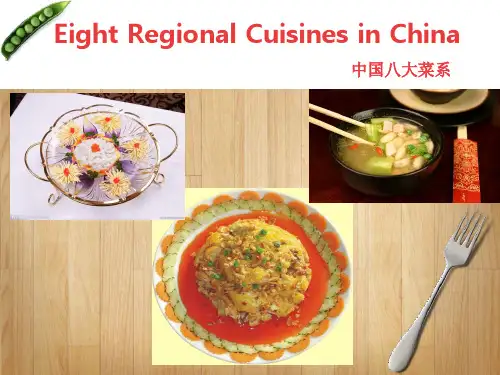

介绍中国八大菜系的英语作文The Eight Major Cuisines of ChinaChina is renowned for its rich and diverse culinary traditions, and the eight major cuisines stand out as the most representative and distinctive.The Sichuan Cuisine is known for its bold and spicy flavors. Dishes like Mapo Tofu and Kung Pao Chicken are favorites due to the generous use of chili peppers and Sichuan peppercorns. The Cantonese Cuisine emphasizes freshness and natural flavors. Dim Sum, Roast Goose, and various seafood dishes are highly popular.The Shandong Cuisine features a wide range of seafood and emphasizes the quality of ingredients. Braised Sea Cucumber and Sweet and Sour Pork are classic examples.The Jiangsu Cuisine is characterized by its delicate and elegant presentation. Dishes such as Stewed Crab with Clear Soup and Yangzhou Fried Rice are well-known.The Zhejiang Cuisine focuses on light and fresh tastes. West Lake Fish in Vinegar Gravy and Dongpo Pork are some of its signature dishes.The Fujian Cuisine is famous for its use of various broths and seafood. Buddha Jumps Over the Wall is a renowned delicacy.The Hunan Cuisine is similar to Sichuan Cuisine in its spiciness, but with its own unique style. Stinky Tofu and Mao's Braised Pork are typical.These eight major cuisines showcase the vast culinary landscape of China, each with its own unique charm and appeal.翻译:《中国八大菜系》中国以其丰富多样的烹饪传统而闻名,八大菜系是最具代表性和独特性的。
介绍中国八大菜系的英语范文Chinese Cuisine: An Exploration of the Eight Culinary TreasuresChina is renowned for its rich and diverse culinary heritage, with a vast array of regional specialties that have captivated the taste buds of people around the world. Among the countless culinary delights that China has to offer, the eight major cuisine styles, often referred to as the "Eight Great Cuisines of China," stand out as the pinnacles of the nation's gastronomic prowess. Each of these distinctive regional cuisines boasts its own unique flavors, cooking techniques, and cultural influences, making them a true feast for the senses.The first of the Eight Great Cuisines is the Cantonese cuisine, which originates from the Guangdong province in southern China. Cantonese cuisine is renowned for its emphasis on fresh, high-quality ingredients and delicate preparation techniques. Dishes such as dim sum, roasted goose, and steamed seafood are hallmarks of this style, showcasing the Cantonese preference for preserving the natural flavors of the ingredients. The use of light sauces and minimal seasoning allows the inherent taste of the food to shine, making Cantonese cuisine a true culinary delight.Secondly, the Sichuan cuisine, hailing from the Sichuan province in southwestern China, is celebrated for its bold and fiery flavors. The signature Sichuan peppercorn, known for its numbing and tingling sensation, is the cornerstone of this cuisine, adding a unique dimension to dishes such as mapo tofu, kung pao chicken, and hot pot. Sichuan cuisine also utilizes a wide range of chili peppers, resulting in a harmonious balance of heat, aroma, and complexity that has captivated taste buds around the world.The Hunan cuisine, originating from the Hunan province in central China, is the third of the Eight Great Cuisines. This style is characterized by its intense spiciness, with a heavy reliance on chili peppers and smoked or pickled ingredients. Hunan cuisine is often described as the "spicier cousin" of Sichuan cuisine, with dishes like Chairman Mao's red-braised pork and steamed fish with chili sauce showcasing the bold and unapologetic flavors that define this regional culinary tradition.The fourth cuisine on the list is the Jiangsu cuisine, which hails from the Jiangsu province in eastern China. Known for its delicate and refined flavors, Jiangsu cuisine emphasizes the natural sweetness of ingredients and the harmonious balance of flavors. Dishes such as Yangzhou fried rice, Nanjing salted duck, and Dongpo pork exemplify the elegance and sophistication of this culinary style, which has been heavily influenced by the region's rich history andcultural heritage.Moving on, the Zhejiang cuisine, originating from the Zhejiang province in eastern China, is the fifth of the Eight Great Cuisines. This style is characterized by its focus on freshness, lightness, and the preservation of natural flavors. Dishes like West Lake beef soup, Dongpo pork, and steamed river fish showcase the Zhejiang cuisine's preference for simple cooking methods and high-quality ingredients, resulting in a delicate and harmonious dining experience.The sixth cuisine on the list is the Fujian cuisine, hailing from the Fujian province in southeastern China. Fujian cuisine is known for its use of seafood, as the province is surrounded by the sea, as well as its emphasis on the umami flavors derived from ingredients like dried seafood and mushrooms. Dishes such as Minnan-style lo mein, steamed grouper with rice wine, and Buddha jumps over the wall exemplify the complex and nuanced flavors that define this regional culinary tradition.The seventh of the Eight Great Cuisines is the Anhui cuisine, which originates from the Anhui province in eastern China. Anhui cuisine is characterized by its use of wild herbs, mountain vegetables, and preserved ingredients, resulting in a unique and earthy flavor profile. Dishes like braised pork belly with bamboo shoots, stir-fried fern tips, and Huangshan mountain chicken showcase the Anhui cuisine'sreliance on local, seasonal ingredients and its commitment to preserving traditional cooking methods.Finally, the eighth and last of the Eight Great Cuisines is the Shandong cuisine, which originates from the Shandong province in northern China. Shandong cuisine is known for its emphasis on the freshness and quality of its ingredients, as well as its use of seafood and a variety of cooking techniques, including steaming, braising, and deep-frying. Dishes like Shandong-style steamed buns, Jiaozhou-style braised pork, and Qingdao-style seafood platters exemplify the Shandong cuisine's focus on simplicity, balance, and the showcasing of high-quality ingredients.Each of the Eight Great Cuisines of China offers a unique and captivating culinary experience, reflecting the rich diversity and cultural heritage of the nation. From the delicate and refined flavors of Cantonese cuisine to the bold and fiery Sichuan dishes, these regional culinary traditions have not only shaped the gastronomic landscape of China but have also captivated the taste buds of people around the world. By exploring these eight culinary treasures, one can embark on a journey of sensory delights, discovering the depth and complexity of Chinese cuisine.。
介绍菜系的英语作文When it comes to the culinary arts China boasts a rich and diverse array of regional cuisines each with its own unique flavors and cooking techniques. In this essay I will introduce some of the most famous Chinese cuisines and their distinct characteristics. 1. Sichuan Cuisine 川菜 Known as one of the most popular and spicy cuisines in China Sichuan cuisine originates from the Sichuan province. It is famous for its bold flavors particularly the pungent spiciness and the unique flavor of Sichuan pepper which creates a numbing sensation on the tongue. Dishes such as Kung Pao Chicken 宫保鸡丁 and Mapo Tofu 麻婆豆腐 are iconic representatives of this cuisine.2. Cantonese Cuisine 粤菜 Originating from the Guangdong province Cantonese cuisine is renowned for its light and fresh flavors. It emphasizes the preservation of the natural taste of ingredients and is known for its variety of cooking methods including steaming stirfrying and roasting. Dim Sum 点心 a style of eating that includes a variety of small bitesized dishes is a quintessential part of Cantonese cuisine.3. Shanghai Cuisine 沪菜 Also known as Hu cuisine it comes from the city of Shanghai. This style of cooking is known for its sweet and slightly sour flavors with a focus on the color aroma and taste of the dishes. Shanghai cuisine is famous for its braised dishes such as Braised Pork Belly 红烧肉 and the sweet and sour flavors of dishes like Sweet and Sour Mandarin Fish 松鼠桂鱼.4. Hunan Cuisine 湘菜 Hunan cuisine from the Hunan province is another spicy cuisine that is famous for its hot and sour flavors. It uses a variety of chili peppers and pickled vegetables to create a distinctive taste. Dishes like Steamed Fish Head with Diced Hot Red Peppers 剁椒鱼头 are emblematic of Hunans bold and spicy style.5. Beijing Cuisine 京菜 Beijing cuisine also known as Jing cuisine is characterized by its simplicity and authenticity. It often uses local ingredients and features dishes like Peking Duck 北京烤鸭 which is considered a national dish of China. The cuisine also includesvarious types of dumplings such as Jiaozi 饺子 and Shuijiao 水饺.6. Fujian Cuisine 闽菜 Originating from the Fujian province this cuisine is known for its emphasis on the natural flavors of the ingredients with a preference for seafood. It is characterized by its lightness freshness and the use of soups and broths. A famous dish from this region is Buddha Jumps Over the Wall 佛跳墙 a rich and complex dish with a variety of seafood and meats.7. Anhui Cuisine 徽菜 Anhui cuisine from the Anhui province is known for its simple and honest flavors often using wild herbs and bamboo shoots. It is less oily compared to other Chinese cuisines and is famous for dishes like Braised Eel in Brown Sauce 红烧鳗鱼 and Smoked TeaFlavored Duck 茶叶熏鸭.8. Zhejiang Cuisine 浙菜 Zhejiang cuisine from the Zhejiang province is known for its fresh soft and smooth flavors. It often features freshwater fish and shrimp as well as bamboo shoots. Dishes like Dongpo Pork 东坡肉 and West Lake Fish in Vinegar Gravy 西湖醋鱼 are famous examples.Each of these regional cuisines not only represents the culinary diversity of China but also reflects the cultural and geographical characteristics of their respective regions. Whether you prefer the spicy kick of Sichuan the delicate flavors of Cantonese or the hearty dishes of Beijing Chinese cuisine offers a vast array of tastes and experiences for food lovers around the world.。